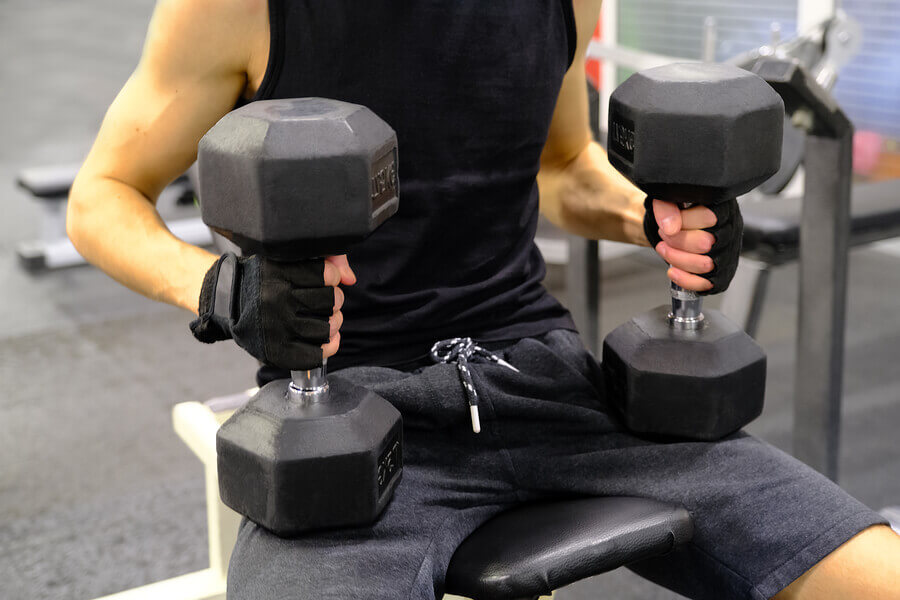4 Common Dumbbell Mistakes

Dumbbells play an important part in reaching our workout goals. But misusing them can lead to pain or injuries. In light of the possible dangers, we’ve prepared today’s post on the most common dumbbell mistakes. We’ll also share some advice on how to use them correctly.
Dumbbell mistakes
You need the correct technique to use dumbbells in your routine. Correct form and execution in every exercise that you tackle will help make your workouts more effective while reducing your risk of injury.
Below, check out the most common dumbbell mistakes:
- Using dumbbells that are too heavy or on the flip side, too light. The wrong weight won’t give you the results you’re looking for. Make sure you take the time to think about the weight you need in order to meet your exercise goals.
- Movements that are too short. As you’re working out, you need to aim for a wide range of movements to make your exercises efficient.
- Starting off strong and burning out before the end of a workout.
- Working out small muscles or muscle groups instead of focusing on bigger ones.
- Not breathing during the exercise. Or in other words, holding in your breath during the workout. Instead, inhale when lifting and exhale when lowering.
- Moving the torso when lifting or lowering the dumbbell. Try focusing your muscle strength on keeping your torso as still as possible throughout the entire workout. Your core muscles play a crucial role here.
- Lifting dumbbells quickly and letting them fall down instead of lowering them. This is a common mistake that stresses the importance of correct execution.

How should you use the dumbbell?
Now that we’ve gone over the most common dumbbell mistakes, check out our advice on using them efficiently and in a way that reduces your risk of injuring yourself.
1. Progressive steps
Don’t start your exercise with the heaviest weight. Your first sets should be lighter; you can even use your first sets as a warm-up to prevent muscle injuries.
In addition, walking through the workout ahead of you and focusing on the movements in your mind is a good way to prepare. Don’t aim to lift heavy weights in your first session. Instead, aim to lift more weight gradually over time.
For example, try 5 x 5 exercises. Work out 8-12 reps, changing up both the number of sets and reps to keep your muscles from becoming used to a certain routine.
2. Working out big muscle groups with dumbbells
As we mentioned earlier in our post, one of the most common dumbbell mistakes is focusing on smaller muscle groups. Instead, training your big muscle groups will allow you to move to heavier weights, which will help your muscles grow overall.
Focus mostly on three big muscle groups: legs, chest, and back but don’t forget about your arms of course.
In addition, we recommend compound exercises as they help increase muscle fiber, which means a more efficient workout. Try this small set of dumbbell exercises and work out your three big muscle groups: military press, bench press, and squats.
3. Control your speed: dumbbell workouts
Steady exercises should define your dumbbell workouts. Fine-tune your technique by avoiding sudden, explosive movements and keeping the same speed throughout all your reps. You need a controlled, consistent speed.

4. Complete, wide-ranged movements
Make sure you have a wide range of movement as it more effectively tones muscles. For example, if you’re doing bicep curls, extend your arm completely and lift your dumbbell up to the level of your shoulder. With a little extra effort, you can benefit from stronger and more flexible muscles.
5. Concentration and intensity
Lastly, avoid going through a workout just because it’s a routine. Stay motivated in order to work out with the intensity that you need for dumbbell workouts.
You have to aim to execute each rep or exercise with as much precision possible. Mental strength and concentration are key components. They’ll allow you to follow through your workout well and focus on your technique.
As you’ve read with us today, working out with dumbbells isn’t as easy as it seems. But if you follow our tips and avoid making the mistakes outlined in our post, dumbbells can be a great asset to any routine. Grab your set and get to work!
Dumbbells play an important part in reaching our workout goals. But misusing them can lead to pain or injuries. In light of the possible dangers, we’ve prepared today’s post on the most common dumbbell mistakes. We’ll also share some advice on how to use them correctly.
Dumbbell mistakes
You need the correct technique to use dumbbells in your routine. Correct form and execution in every exercise that you tackle will help make your workouts more effective while reducing your risk of injury.
Below, check out the most common dumbbell mistakes:
- Using dumbbells that are too heavy or on the flip side, too light. The wrong weight won’t give you the results you’re looking for. Make sure you take the time to think about the weight you need in order to meet your exercise goals.
- Movements that are too short. As you’re working out, you need to aim for a wide range of movements to make your exercises efficient.
- Starting off strong and burning out before the end of a workout.
- Working out small muscles or muscle groups instead of focusing on bigger ones.
- Not breathing during the exercise. Or in other words, holding in your breath during the workout. Instead, inhale when lifting and exhale when lowering.
- Moving the torso when lifting or lowering the dumbbell. Try focusing your muscle strength on keeping your torso as still as possible throughout the entire workout. Your core muscles play a crucial role here.
- Lifting dumbbells quickly and letting them fall down instead of lowering them. This is a common mistake that stresses the importance of correct execution.

How should you use the dumbbell?
Now that we’ve gone over the most common dumbbell mistakes, check out our advice on using them efficiently and in a way that reduces your risk of injuring yourself.
1. Progressive steps
Don’t start your exercise with the heaviest weight. Your first sets should be lighter; you can even use your first sets as a warm-up to prevent muscle injuries.
In addition, walking through the workout ahead of you and focusing on the movements in your mind is a good way to prepare. Don’t aim to lift heavy weights in your first session. Instead, aim to lift more weight gradually over time.
For example, try 5 x 5 exercises. Work out 8-12 reps, changing up both the number of sets and reps to keep your muscles from becoming used to a certain routine.
2. Working out big muscle groups with dumbbells
As we mentioned earlier in our post, one of the most common dumbbell mistakes is focusing on smaller muscle groups. Instead, training your big muscle groups will allow you to move to heavier weights, which will help your muscles grow overall.
Focus mostly on three big muscle groups: legs, chest, and back but don’t forget about your arms of course.
In addition, we recommend compound exercises as they help increase muscle fiber, which means a more efficient workout. Try this small set of dumbbell exercises and work out your three big muscle groups: military press, bench press, and squats.
3. Control your speed: dumbbell workouts
Steady exercises should define your dumbbell workouts. Fine-tune your technique by avoiding sudden, explosive movements and keeping the same speed throughout all your reps. You need a controlled, consistent speed.

4. Complete, wide-ranged movements
Make sure you have a wide range of movement as it more effectively tones muscles. For example, if you’re doing bicep curls, extend your arm completely and lift your dumbbell up to the level of your shoulder. With a little extra effort, you can benefit from stronger and more flexible muscles.
5. Concentration and intensity
Lastly, avoid going through a workout just because it’s a routine. Stay motivated in order to work out with the intensity that you need for dumbbell workouts.
You have to aim to execute each rep or exercise with as much precision possible. Mental strength and concentration are key components. They’ll allow you to follow through your workout well and focus on your technique.
As you’ve read with us today, working out with dumbbells isn’t as easy as it seems. But if you follow our tips and avoid making the mistakes outlined in our post, dumbbells can be a great asset to any routine. Grab your set and get to work!
All cited sources were thoroughly reviewed by our team to ensure their quality, reliability, currency, and validity. The bibliography of this article was considered reliable and of academic or scientific accuracy.
- Gunning, J.L., Callaghan, J.P. y MacGull, S.M. (2001). Spinal posture and prior loading history modulate compressive strength and type of failure in the spine: a biomechanical study using a porcine cervical spine model. Clinical Biomechanics, 16, 471-480.
- Morán-Navarro, R., Martínez-Cava, A., Sánchez-Medina, L., Mora-Rodríguez, R., González-Badillo, J. J. & Pallarés, J. G. (2019). Movement velocity as a measure of level of effort during resistance exercise.
This text is provided for informational purposes only and does not replace consultation with a professional. If in doubt, consult your specialist.








